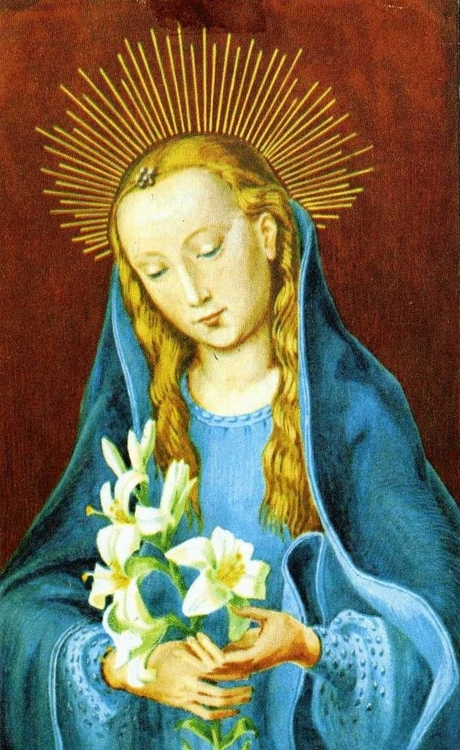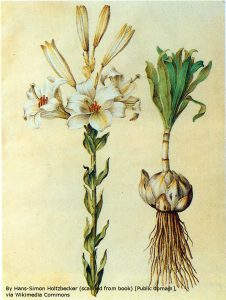By Robbie Blackhall-Miles

http://allaboutmary.tumblr.com
Not realising the hope they give me, through their winter rosettes of green, the bulbs of the Madonna lily (Lilium candidum) sit snugly in the soil year on year producing an ever-widening clump. Naturalised across Europe, and finding a happy home in the gardens of the UK, they hail from the Eastern end of the Mediterranean and still survive, albeit in a fragmented state, in the land to which they are most closely associated.
High up on Israel’s Carmel mountain, above the city of Haifa, the lilies are to be found in their crowded clumps fragmented and clinging on in crevices or protected from grazing animals, and the hands of wild bulb collectors, amongst the thorny Maquis vegetation dominated by Oaks (Quercus calliprinos), Ziziphus spina-christi and Mastic (Pistacia sp). They are now considered one of Israel’s most threatened species.
The mount on which they flower was a revered place for the early Jews in Israel and particularly for King Solomon. It features in the Old Testament Book ‘Song of Solomon’ with the line “your head crowns you like Mount Carmel” (Song of Solomon 7:5). The title of the book and the song took on King Solomon’s name due to his mention throughout the book. There is, however, evidence that the book was written by Solomon himself during the early part of his reign as king. The first line of the poem seems to state who wrote it ‘The song of songs, which is Solomon’s’ (Song of Solomon 1:1).
The links between Solomon and Lilium candidum are strong; the Bible describes the pillars of Solomon’s temple as having engravings of lilium candidum and the seal of Solomon (the Star of David) depicts a hexagram, a six-pointed star, the unification between masculine and feminine, the 6 petals of a lily. The song of Solomon describes an intimate love story; the interpretation of which has changed over time. In the 12th century the belief was that the bride mentioned in the song was Solomon’s prediction of the Virgin Mary and it is the line in this same song describing her that gives the lily its place at Christmas.
” I am a rose of Sharon, a lily of the valleys. As the lily among thorns, so is my love among the maidens (virgins).” (Song of Songs 2:2).

The depiction of beauty and purity using the lily as a metaphor was picked up on heavily by medieval artists. They depicted Mary with a lily at the annunciation and images of her holding a lily in one hand to show her purity and her son, Jesus, in the other. It is this depiction that gives Lilium candidum the colloquial name of Madonna lily. The image of a fleur-de-lis (Flower of the lily) is also often depicted in this work and may represent L. candidum rather than the Iris that it is often said to be. Over time the idea of what ‘the lily amongst the thorns’ meant has become confused. In Biblical times the name used for the lily was ‘Shoshanna’ meaning six petaled flower, but modern Hebrew uses Shoshanna as the name for a rose. The Virgin Mary is almost as often depicted with roses as she is with lilies and this seems to stem from something lost in translation; as the flower amongst the thorns? However, the etymology of Shoshanna שושנה states quite clearly that the flower had six petals, where a rose has five, – shishi שִׁשִּׁי (from which Shosh is derived) being the ancient Hebrew for six.
By incident, if your name happens to be Susan, Susanna, Anne, Ann or Anna then it is derived from this ancient Hebrew name for the lily.

Of course, this seems to be the most tenuous of links between Christmas and the Lily but there is a further one – Solomon, and his father King David (who’s symbol seems to have been the flowers of Lilium candidum), were ancestors of Jesus Christ (Matthew 1:1–17) whom we celebrate at this festive time of year. Does that then mean that this beautiful white lily, that conjures up ideas of purity, peace and brightness, is also a symbol of Christ himself? I don’t know.
What I do know is that the Crusaders found it growing in Israel and introduced it to Europe where it was received as a symbol of the holy land. It has been here gracing our gardens with its winter rosettes of green and the purity of its early spring flowers ever since. In the darkest days of winter its leaves bring me hope of the bright light its flowers will give me later in the year, just as the celebration of Christmas is a celebration of hope, brightness and light for all humanity.
